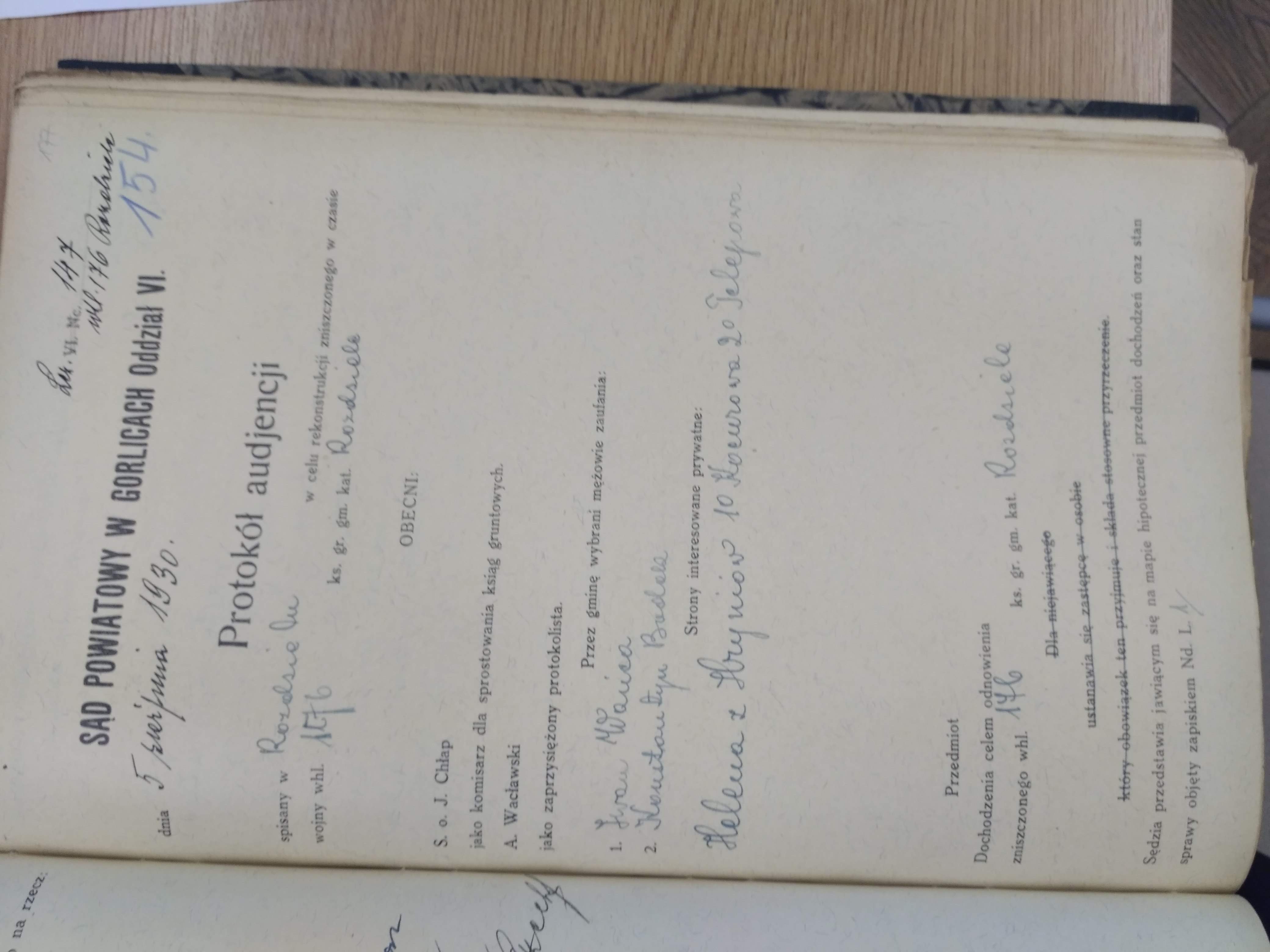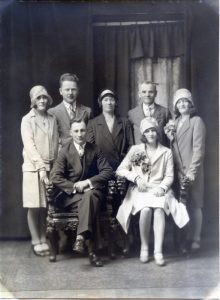Theodor Kocur and Helena Hrynia of Passaic, New Jersey
Theodorus Kocur [4329] was born in House 15, Rozdziele in 1872. We don't have his birth record because the birth records from that year are missing, but we know his exact date of birth (March 3) because it is stated on his marriage record.
Theodor emigrated to America sometime prior to 1895. He wound up in Passaic, New Jersey, where he married Helena Hrynia [4330], a native of Újak, a village in Saros county, Hungary (modern-day Údol, Slovakia).
Although she was technically a subject of the Kingdom of Hungary, Helena was most likely not of the Magyar ethnicity. Saros county was deep in the heartland of the Carpatho-Rusyn people, and she would therefore have shared language and customs with the people of Theodor's village, which lay just 80 km away to the north, across the Carpathian Mountains. Because the men and women of Rozdziele would often travel across the mountains to seek seasonal agricultural work in Hungary, there is a chance that Theodor and Helena knew each other before they left for America.
It would have been natural for them to find their way to Passaic:
The City of Passaic was a major area of immigration between the years of 1882 to 1920 and the immigrants who came to this city brought with them not only their language and religion, but also cherished traditions which included marriage customs. Most Ruthenians who came to this city mostly originated from Eastern Slovakia, former Saros county...
(Carpatho-Rusyn Immigrant Marriage Traditions: Passaic, New Jersey - Circa 1910 to 1930 by Joy E. Kovalycsik, https://www.tccweb.org/newjersey.htm#Carpatho-Rusyn_Immigrant_Marriage_Traditions_, retrieved Aug 16, 2022.)
They were married on September 28, 1895, at St. Michael's Greek Catholic Church, which was a focal point for Passaic's Carpatho-Rusyn immigrant community. We can see from their marriage record that the officiant was A.R.D. (Admodum Reverendus Doctor, Right Reverend Doctor) Eugenius Szatała.
Again from the website quoted above,
Saint Michael’s originally had a seating capacity of 300 individuals. Father Chanath worked tirelessly to expand the church and when his tenure ended on December 20, 1894, Saint Michael’s was firmly established. Bishop Wigger of Newark then appointed Father Eugene Szatala to oversee the new church. During Father Szatalas tenure the parish grew in large part via the constant immigration from Eastern Europe and, this was the only church for Greek Catholics in Passaic.The witnesses to the marriage were Gregorius Dzama from Bednarka, a village near the groom's home Rozdziele on the Galician side of the mountains, and Joannes Knap, who was from Újak in Hungary, like the bride.
(St. Michael's History by Joy E. Kovalycsik, https://www.tccweb.org/newjerseychurchesmikes.htm#stmikeshistory, retrieved Aug 16, 2022.)
Their first son Michael [11223] was born in Passaic a year later, on August 14, 1896. Neighbors who stood as godparents were Joannes Wancio from Újak and Julia Dziama from Bednarka. Again, it was Rev. Szatała who performed the baptism and confirmation two days later, on August 16.
So far I have not been able to find any trace of Michael's birth in the New Jersey public records. If the family was enumerated in the 1900 Federal Census, I have not yet found the record. At some point prior to March 1901 they returned to Theodor's home village of Rozdziele, where their second son Georgius [11208] was born on March 17, 1901.
They must have carried documentation with them from the church in Passaic, because their marriage record and Michael's birth record were inserted into the Rozdziele metrical registers at the end of 1901. It is interesting that in the margin of Theodor and Helena's marriage record, the priest in Rozdziele (who at that time was Rev. Basilius Kuryłło) wrote the groom's address at the time of the wedding, as was customary:
House number 54 in Passaic, America...indicating that the priest was probably unfamiliar with the North American custom of identifying addresses by house number and street name.
The family settled in House 15, Theodor's ancestral home, which had been in Theodor's family for at least four generations. It is possible that the family returned to America at least once; I have found a very similar family living in Passaic at the time of the 1905 New Jersey State Census. But there are inconsistencies, and I am not certain that I have identified the correct family.
What is certain is that Theodor died in Rozdziele on November 11, 1919 at the age of 47. A little over a year later Helena, 45 years old, married widower Josaphat Telep [7715], almost 20 years her senior, who had lost his wife the previous year and whose last surviving son had departed for Canada 15 years earlier.
Michael may have returned to America to live out the rest of his life (the evidence is inconclusive) but Georgius stayed in House 15. He married Anna Dudra [11332] and brought her into the house; their son Paulus was born there on March 4, 1926. Helena, it appears, lived with Josaphat in House 60.
One interesting later piece of evidence I have of the family is a court proceeding that took place on August 5, 1930 at the Gorlice County Court (Gorlice is the county seat and the main large town near Rozdziele).
Protokól audjencji spisany w Rozdzielu w celu rekonstrukcji zniszczonego w czasie wojny whl. 176 ks. gr. gm. kat. RozdzieleMinutes of a hearing written in Rozdziele concerning the reconstruction of wartime damage to property 176, commune land register of Rozdziele

Click to enlarge.
The "interested party" (Strony interesowane) is Helena nee Hrynia, first [husband] Kocur, second [husband] Telep (Helena z Hryniowa 1o Kocurowa 2o Telepowa). Clearly this pertains to our Helena. What was she doing in court?
Briefly: at the outbreak of the First World War, the Russian army quickly over-ran most of the Austrian Empire north of the Carpathian Mountains, and this included Rozdziele. By the end of 1914 the Eastern Front was established a few miles west of Rozdziele in a north-south line that ran through the western suburbs of Gorlice. Thus, Rozdziele was under Russian occupation during this period. In May, 1915, the German High Command chose the Gorlice-Tarnów sector as the place to punch through the Russian lines and launch their counter-offensive, and that area (including Rozdziele and the surrounding villages) suffered a withering artillery bombardment prior to the German and Austrian advance. The Russians retreated, and were ultimately pushed back where they came from.
Poland was recreated after the war, and much of Austrian Galicia was incorporated into it. It appears that the new Polish government offered compensation to families whose houses had been damaged in the war, and in 1930, 12 years after the formal end of hostilities (although, in fact, the war in the East continued for several years after the Armistice of 1918), Helena was still trying to get her claim processed. The fact that only Helena is mentioned on the document, not Josaphat, tells me that the property in question was probably Theodor Kocur's ancestral home, House 15, which Helena would likely still have had an interest in.
I do not know the outcome of Helena's claim. And it would be interesting to know what hardships the family underwent during the war, that may have led to Theodor's death at the relatively young age of 47 in 1919.
A few months after this court proceeding, and after 10 years of marriage with Helena, Josaphat died on January 7, 1931 at the age of 79.
After that, I lose track of the family of Theodor Kocur and Helena Hrynia in Rozdziele.

